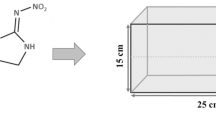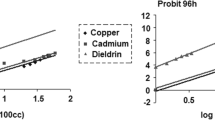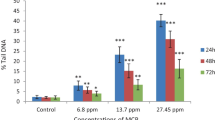Abstract
The acute effects of the organophosphate insecticide fenitrothion on Dicentrarchus labrax juveniles were investigated through a bioassay using biomarkers and swimming behaviour as effect criteria. After 96 h of exposure to sub-lethal concentrations of fenitrothion, the swimming velocity and several biomarkers were individually determined, namely: brain acetylcholinesterase (AChE) activity; muscle cholinesterases (ChE), lactate dehydrogenase and isocitrate dehydrogenase activities; liver ethoxyresorufin-O-deethylase (EROD), glutathione S-transferases, glutathione peroxidase, glutathione reductase, catalase and superoxide dismutase (SOD) activities and lipid peroxidation levels (LPO). A significant decrease of the swimming velocity (LOEC = 2 mg l−1), an inhibition of both AChE (LOEC = 0.06 mg l−1) and ChE activities (LOEC = 0.03 mg l−1), and a positive and significant correlation between the swimming velocity and AChE were found in exposed fish, suggesting an influence of the inhibition of these enzymes in the swimming velocity decrease. An increase of EROD activity (LOEC = 1 mg l−1), indicating the involvement of this enzyme in fenitrothion biotransformation, and a negative and significant correlation between EROD activity and swimming velocity were also found, suggesting that the two findings may somehow be related. Furthermore, results show a significant induction of SOD (LOEC = 0.13 mg l−1) without LPO increase, suggesting that the enzyme is preventing oxidative stress damage. No significant alterations were found in any of the other parameters tested. Thus, exposure of seabass to fenitrothion in the wild at concentrations similar to those tested here may have adverse consequences at population level as neurotransmission and swimming ability are essential for fish performance and survival.




Similar content being viewed by others
References
Amiard-Triquet C (2009) Behavioural disturbances: the missing link between sub-organismal and supra-organismal responses to stress? Prospects based on aquatic research. Hum Ecol Risk Assess 15:87–110
Baatrup E (2009) Measuring complex behaviour patterns in fish—effects of endocrine disruptors on the guppy reproductive behaviour. Hum Ecol Risk Assess 15:53–62
Ballesteros ML, Durando PE, Nores ML, Díaz MP, Bistoni MA, Wunderlin DA (2009) Endosulfan induces changes in spontaneous swimming activity and acetylcholinesterase activity of Jenynsia multidentata (Anablepidae, Cyprinodontiformes). Environ Pollut 157:1573–1580
Banni M, Jebali J, Guerbej H, Dondero F, Boussetta H, Viarengo A (2010) Mixture toxicity assessment of nickel and chlorpyrifos in the sea bass Dicentrarchus labrax. Arch Environ Contam Toxicol [Epub ahead of print]
Beauvais SL, Jones SB, Brewer SK, Little EE (2000) Physiological measures of neurotoxicity of diazinon and malathion to larval rainbow trout (Oncorhynchus mykiss) and their correlation with behavioural measures. Environ Toxicol Chem 19(7):1875–1880
Beauvais SL, Jones SB, Parris JT, Brewer SK, Little EE (2001) Cholinergic and behavioral neurotoxicity of carbaryl and cadmium to larval rainbow trout (Oncorhynchus mykiss). Ecotoxicol Environ Saf 49:84–90
Billiard SM, Bols NC, Hodson PV (2004) In vitro and in vivo comparisons of fish-specific CYP1A induction relative potency factors for selected polycyclic aromatic hydrocarbons. Ecotoxicol Environ Saf 59(3):292–299
Bird RP, Draper AH (1984) Comparative studies on different methods of malondyhaldehyde determination. Methods Enzymol 90:105–110
Bradford M (1976) A rapid and sensitive method for the quantification of microgram quantities of protein utilizing the principle of protein-dye binding. Anal Biochem 72:248–254
Brewer SK, Little EE, DeLonay AJ, Beauvais SL, Jones SB, Ellersieck MR (2001) Behavioural dysfunction correlate to altered physiology in rainbow trout (Oncorhynchus mykiss) exposed to cholinesterase-inhibiting chemicals. Arch Environ Contam Toxicol 40:70–76
Burke MD, Mayer RT (1974) Ethoxyresorufin: direct fluorimetric assay of a microsomal-O-deethylation which is preferentially inducible by 3-methylcholantrene. Drugs Metab Dispos 2:583–588
Calò M, Bitto A, Lo Cascio P, Polito F, Lauriano ER, Minutoli L, Altavilla D, Squadrito F (2009) Cytochrome P450 (CYP1A) induction in sea bream (Sparus aurata) gills and liver following exposure to polychlorobiphenyls (PCBs). Vet Res Commun 33(1):181–184
Carlberg I, Mannervik B (1985) Glutathione reductase. Methods Enzymol 113:484–490
Castro BB, Sobral O, Guilhermino L, Ribeiro R (2004) An in situ bioassay integrating individual and biochemical responses using small fish species. Ecotoxicology 13:667–681
Clairborne A (1985) Catalase activity. In: Greenwald RA (ed) CRC handbook of methods in oxygen radical research. CRC Press, Boca Raton, pp 283–284
Cong NV, Phuong NT, Bayley M (2009) Effects of repeated exposure of diazinon on cholinesterase activity and growth in snakehead fish (Channa striata). Ecotoxicol Environ Saf 72:699–703
Damásio J, Guilhermino L, Soares AMVM, Riva MC, Barata C (2007) Biochemical mechanisms of resistance in Daphnia magna exposed to the insecticide fenitrothion. Chemosphere 70:74–82
Dell’Omo G (2002) Behavioural ecotoxicology. Wiley, Chichester
Dezfuli BS, Simoni E, Giari L, Manera M (2006) Effects of experimental terbuthyllazine exposure on the cells of Dicentrarchus labrax (L.). Chemosphere 64:1684–1694
Diamantino TC, Almeida E, Soares AMVM, Guilhermino L (2001) Lactate dehydrogenase activity as an effect criterion in toxicity tests with Daphia magna Straus. Bull Environ Contam Toxicol 57:979–985
Ecobichon D (2001) Toxic effects of pesticides. In: Klaasen CD, Amdur MO, Doull J (eds) Cassaret and Doull’s toxicology: the basic science of poisons. McGraw-Hill, New York, pp 165–176
Elia AC, Galarini R, Taticchi MI, Dorr AJ, Mantilacci L (2003) Antioxidant responses and bioaccumulation in Ictalurus melas under mercury exposure. Ecotoxicol Environ Saf 55:162–167
Ellis G, Goldberg DM (1971) An improved manual and semi-automatic assay for NADP-dependent isocitrate dehydrogenase activity, with a description of some kinetic properties of human liver and serum enzyme. Clin Biochem 2:175–185
Ellman GL, Courtney KD, Andres V Jr, Feather-Stone RM (1961) A new and rapid colorimetric determination of aceylcholinesterase activity. Biochem Pharmacol 7:88–95
Escartin E, Porte C (1996) Bioaccumulation, metabolism and biochemical effects of the organophosphorous pesticide fenitrothion in Procambarus clarkii. Environ Toxicol Chem 15(6):915–920
Ferrari A, Venturino A, de D’Angelo AMP (2007) Effects of carbaryl and azinphosmethyl on juvenile rainbow trout (Oncorhynchus mykiss) detoxifying enzymes. Pest Biochem Physiol 88:134–142
Ferreira M, Caetano M, Antunes P, Costa J et al (2010) Assessment of contaminants and biomarkers of exposure in wild and farmed seabass. Ecotoxicol Environ Saf 73:579–588
Flammarion P, Migeon B, Urios S, Morfin P, Garric J (1998) Effect of methidathion on the cytochrome P-450 1A in the cyprinid fish gudgeon (Gobio gobio). Aquat Toxicol 42(2):93–102
Flohé L, Günzler WA (1984) Assays of glutathione peroxidase. Methods Enzymol 105:114–121
Flohé L, Ötting F (1984) Superoxide dismutase assays. Methods Enzymol 105:93–104
Forbes VE, Palmqvist A, Bach L (2006) The use and misuse of biomarkers in ecotoxicology. Environ Toxicol Chem 25(1):272–280
Förlin L, Hylland K (2006) Hepatic cytochrome P4501A concentration and activity in Atlantic cod caged in two North Sea pollution gradients. In: Hylland K, Lang T, Vethaak AD (eds) Biological effects of contaminants in marine pelagic ecosystems. Society of Environmental Toxicology and Chemistry (SETAC), Pensacola
Frasco MF, Guilhermino L (2002) Effects of dimethoate and betanaphthoflavone on selected biomarkers of Poecilia reticulata. Fish Physiol Biochem 26:149–156
Fulton MH, Key PB (2001) Acetylcholinesterase inhibition in estuarine fish and invertebrates as an indicator of organophosphorous insecticide exposure and effects. Environ Toxicol Chem 20(1):37–45
Galloway TS (2006) Biomarkers in environmental and human health risk assessment. Mar Pollut Bull 53:606–613
Galloway TS, Millward N, Browne MA, Depledge MH (2002) Rapid assessment of organophosphrous/carbamate exposure in the bivalve mollusc Mytilus edulis using combined esterase activities as biomarkers. Aquat Toxicol 61:169–180
Galloway TS, Browne MA, Dissanayake A, Lowe D, Jones MB, Depledge MH (2004) A multibiomarker approach to environmental assessment. Environ Sci Technol 38:1723–1731
Gravato C, Guilhermino L (2009) Effects of benzo(a)pyrene on seabass (Dicentrarchus labrax L.): biomarkers, growth and behaviour. Hum Ecol Risk Assess 15:121–137
Gravato C, Santos M (2003) Dicentrarchus labrax biotransformation and genotoxicity responses after exposure to a secondary treated industrial/urban effluent. Ecotoxicol Environ Saf 55(3):300–306
Guilhermino L, Lopes MC, Carvallho AP, Soares AMVM (1996) Acetylcholinesterase activity in juveniles of Daphnia magna Straus. Bull Environ Contam Toxicol 57:979–985
Guilhermino L, Barros P, Silva MC, Soares AMVM (1998) Should the use of inhibition of cholinesterases as a specific biomarker for organophosphate and carbamate pesticides be questioned? Biomarkers 3:157–163
Guilhermino L, Lacerda MN, Nogueira A, Soares AMVM (2000) In vitro and in vivo inhibition of Daphnia magna acetylcholinesterase by surfactant agents: possible implications for contamination biomonitoring. Sci Total Environ 247:137–141
Habig WH, Pabst MJ, Jakoby WB (1974) Glutathione-S-transferases, the first enzymatic step in mercapturic acid formation. J Biol Chem 249:7130–7139
Hagger JA, Jones MB, Lowe D, Paul Leonard DR, Owen R, Galloway TS (2008) Application of biomarkers for improving risk assessments of chemicals under the Water Framework Directive: a case study. Mar Pollut Bull 56:1111–1118
Hannam ML, Hagger JA, Jones MB, Galloway TS (2008) Characterisation of esterases as potential biomarkers of pesticide exposure in the lugworm Arenicola marina (Annelida: Polychaeta). Environ Pollut 152(2):342–350
Hansson T, Schiedek D, Lehtonen KK, Pekka J et al (2006) Biochemical biomarkers in adult female perch (Perca fluviatilis) in a chronically polluted gradient in the Stockholm recipient (Sweden). Mar Pollut Bull 53(8):451–468
Heath AG, Cech JJ, Bink L, Moberg P, Zinkl JG (1997) Physiological responses of fathead minnow larvae to rice pesticides. Ecotoxicol Environ Saf 37:280–288
Hodson PV, Kloepper-Sams PJ, Munkittrick KR, Lockhart WL, Metner DA, Luxon PL, Smith IR, Gagnon MM, Servos M, Payne JF (1991) Protocols for measuring mixed function oxygenases of fish liver. Canadian Technical Report of Fisheries and Aquatic Sciences 1829
Jo SH, Son MK, Koh HJ, Lee SM et al (2001) Control of mitochondrial redox balance and cellular defense against oxidative damage by mitochondrial NADP+-dependent isocitrate dehydrogenase. J Biol Chem 276(19):16168–16176
Kavitha P, Rao JV (2007) Oxidative stress and locomotory behaviour response as biomarkers for assessing recovery status of mosquito fish (Gambusia affinis) after lethal effect of an organophosphate pesticide, monocrotophos. Pesticide Biochem Physiol 87:182–188
Kavitha P, Rao JV (2009) Sub-lethal effects of profenophos on tissue-specific antioxidant responses in a euryhyaline fish Oreochromis mossambicus. Ecotoxicol Environ Saf 72:1727–1733
Kennedy CJ, Farrell AP (2006) Effects of exposure to the water-soluble fraction of crude oil on the swimming performance and the metabolic and ionic recovery post-exercise in Pacific herring (Clupea pallasi). Environ Toxicol Chem 25:2715–2724
Kienle C, Köhler HR, Filser J, Gerhardt A (2008) Effects of nickel chloride and oxygen depletion on behaviour and vitality of zebra fish Danio rerio (Hamilton, 1822) (Pisces, Cypriniformes) embryos and larvae. Environ Pollut 152:612–620
Kitamura S, Kadota T, Yoshida M, Jinno N, Ohta S (2000) Whole-body metabolism of the organophosphorus pesticide, fenthion, in goldfish, Carassius auratus. Comp Biochem Physiol C 126(3):259–266
Labrot F, Ribeira D, Saint-Denis M, Narbonne JF (1996) In vitro and in vivo studies of potential biomarkers of lead and uranium contamination: lipid peroxidation, acetylcholinesterase, catalase and glutathione peroxidase activities in three non-mammalian species. Biomarkers 1:21–28
Lee SM, Koh H-J, Park DL, Song BJ, Huh TL (2002) Cytosolic NADP+-dependent isocitrate dehydrogenase status modulates oxidative damage to cells. Free Radic Biol Med 32(11):1185–1196
Lemaire P, Berhaut J, Lemaire-Gony S, Lafaurie M (1992) Ultrastructural changes induced by benzo(a)pyrene in seabass (Dicentrarchus labrax) liver and intestine: importance of the intoxication route. Environ Res 57(1):59–72
Lemaire P, Förlin L, Livingstone DR (1996) Responses of hepatic biotransformation and antioxidant enzymes to CYP1A-inducers (3-methylcholantrene) in sea bass (Dicentrarchus labrax), dab (Limanda limanda) and rainbow trout (Oncorhynchus mykiss). Aquat Toxicol 36:141–160
Lemaire-Gony S, Lemaire P, Pulsford AL (1995) Effects of cadmium and benzo(a)pyrene on the immune system, gill ATPase and EROD activity of European seabass Dicentrarchus labrax. Aquat Toxicol 31(4):297–313
Levi PE, Hollingworth RM, Hodgson E (1988) Differences in oxidative dearylation and desulfuration of fenitrothion by cytochrome P-450 isozymes and in the subsequent inhibition of monooxygenase activity. Pest Biochem Physiol 32(3):224–231
Lima I, Moreira SM, Osten JR, Soares AMVM, Guilhermino L (2007) Biochemical responses of the marine mussel Mytilus galloprovincialis to petrochemical environmental contamination along the Northwestern coast of Portugal. Chemosphere 66:1230–1242
Livingstone DR (2001) Contaminant-stimulated reactive oxygen species production and oxidative damage in aquatic organisms. Mar Pollut Bull 42(8):656–666
Mcintosh AD, Hylland K, Gowland BTG, Davies IM (2006) Assessment of hepatic 7-ethoxiresorufin O-deethylase activity and CYP1A concentration in herring (Clupea harengus) and saithe (Pollachius virens) from two areas of the North Sea. In: Hylland K, Lang T, Vethaak AD (eds) Biological effects of contaminants in marine pelagic ecosystems. Society of Environmental Toxicology and Chemistry (SETAC), Pensacola
Miyamoto J, Takimoto Y, Mihara K (1979) Metabolism of organophosphorous insecticides in aquatic organisms, with special emphasis on fenitrothion. In: Kahn MAQ, Lech JJ, Menn JJ (eds) Pesticide and xenobiotic metabolism in aquatic species. ACS symposium series. American Society, Washington, DC, p 145
Moreira SM, Lima I, Ribeiro R et al (2006) Effects of estuarine sediment contamination on feeding and on key physiological functions of the polychaete Hediste diversicolor. Laboratory and in situ assays. Aquat Toxicol 78:186–201
Moyle PB, Cech JJ (2003) Fishes: an introduction to ichthyology, 5th edn. Prentice Hall, Upper Saddle River, pp 192–196
Novi S, Pretti C, Cognetti AM, Longo V, Marchetti S, Gervasi PG (1998) Biotransformation enzymes and their induction by ß-naphtoflavone in adult sea bass (Dicentrarchus labrax). Aquat Toxicol 41:63–81
OECD (1992) OECD guidelines for the testing of chemicals. Test 203: fish, acute toxicity test
Ohkawa H (1979) Assay for lipid peroxides in animal tissues by thiobarbituric acid reaction. Anal Biochem 95:351–358
Oruç EO (2010) Oxidative stress, steroid hormone concentrations and acetylcholinesterase activity in Oreochromis niloticus exposed to chlorpyrifos. Pest Biochem Physiol 96:160–166
Payne JF, Mathieu A, Melvin W, Fancey LL (1996) Acetylcholinesterase, and old biomarker with a new future? Field trials in association with two urban rivers and a paper mill in Newfoundland. Mar Pollut Bull 32(2):225–231
Peakall DB, Thompson H, Baatrup E (2002) Relationship between behaviour and the biochemical/physiological biomarkers of exposure to environmental pollutants. In: Dell’Omo G (ed) Behavioural ecotoxicology. Wiley, Chichester, pp 187–208
Peña-Llopis S, Ferrando MD, Peña JB (2003) Fish tolerance to organophosphate-induced oxidative stress is dependent on the gluthathione metabolism and enhanced by N-acetylcisteine. Chemosphere 45:671–681
Pickett GD, Pawson MG (1994) Seabass: biology, exploitation and conservation. Fish and fisheries series 12. Chapman & Hall, London
Piner P, Sevgiler Y, Uner N (2007) In vivo effects of fenthion on oxidative processes by the modulation of glutathione metabolism in the brain of Oreochromis niloticus. Environ Toxicol 22(6):605–612
Rees CB, McCormick SD, Vanden Heuvel JP, Li W (2003) Quantitative PCR analysis of CYP1A induction in Atlantic salmon (Salmo salar). Aquat Toxicol 62(1):67–78
Sancho E, Ferrando MD, Andreu E (1997) Response and recovery of brain acetylcholinesterase activity in the European eel, Anguilla anguilla, exposed to fenitrothion. Ecotoxicol Environ Saf 38:205–209
Sancho E, Fernandez-Vega C, Villarroel MJ, Andreu-Moliner E, Ferrando MD (2009) Physiological effects of tricyclazole on zebrafish (Danio rerio) and post-exposure recovery. Comp Biochem Physiol C 150:25–32
Sandahl JF, Baldwin DH, Jenkins JJ et al (2005) Comparative thresholds for acetylcholinesterase inhibition and behavioural impairment in coho salmon exposed to chlorpyrifos. Environ Toxicol Chem 24:136–145
Schlenk D (2005) Pesticide biotransformation in fish. Biochem Mol Biol Fish 6:171–190
Scott GR, Sloman KA (2004) The effects of environmental pollutants on complex fish behaviour: integrating behavioural and physiological indicators of toxicity. Aquat Toxicol 68:369–392
Solomon SS, De Fang F, Shao-nan L (2000) Hepatic glutathione S-transferase activity in mosquito fish (Gambusia affinis) and topmouth gudgeon (Pseudorasobora parva) exposed to fenitrothion. J Zhejiang Univ Sci 1(2):190–195
Stegeman JJ, Kloepper-Sams PJ (1987) Cytochrome P-450 enzymes and monooxygenase activity in aquatic animals. Environ Health Perspect 71:87–95
Stegeman JJ, Schlezinger JJ, Craddock JE, Tillitt DE (2001) Cytochrome P450 1A expression in midwater fishes: potential effects of chemical contaminants in remote oceanic zones. Environ Sci Technol 35(1):54–62
Torres MA, Testa CP, Gáspari C et al (2002) Oxidative stress in the mussel Mytella guyanensis from polluted mangroves on Santa Catarina Island. Brazil Mar Pollut Bull 44:923–932
Van der Oost R, Beyer J, Vermeulen NPE (2003) Fish bioaccumulation and biomarkers in environmental risk assessment: a review. Environ Toxicol Pharmacol 13:57–149
Varò I, Navarro JC, Amat F, Guilhermino L (2003) Effect of dichlorvos on cholinesterase activity of the European seabass (Dicentrarchus labrax). Pesticide Biochem Physiol 75:61–72
Vassault A (1983) Lactate dehydrogenase. In: Bergmeyer HV (ed) Methods in enzymatic analysis, vol 3. Verlag Chemie, Weinheim, pp 118–126
Vieira LR, Sousa A, Frasco MF, Lima I, Morgado F, Guilhermino L (2008) Acute effects of benzo[a]pyrene, anthracene and a fuel oil on biomarkers of the common goby Pomatoschistus microps (Teleostei, Gobiidae). Sci Total Environ 395(2–3):87–100
Vieira LR, Gravato C, Soares AMVM, Morgado F, Guilhermino L (2009) Acute effects of copper and mercury on the estuarine fish Pomatoschistus microps: linking biomarkers to behaviour. Chemosphere 76:1416–1427
Walker CH, Hopkin SP, Sibly RM, Peakall DB (2001) Principles of ecotoxicology, 2nd edn. Taylor and Francis, London
Wallace WG, Estephan A (2004) Differential susceptibility of horizontal and vertical swimming activity to cadmium exposure in a gammaridean amphipod (Gammarus lawrencianus). Aquat Toxicol 69:289–297
Weber DN, Dingel WM, Panos JJ et al (1997) Alterations in neurobehavioral responses in fishes exposed to lead and lead-chelating agents. Am Zool 37:354–362
Weis JS, Smith G, Zhou T, Santiago-Bass C, Weis P (2001) Effects of contaminants on behaviour: biochemical mechanisms and ecological consequences. Bioscience 51(3):209–217
Whyte JJ, Jung RE, Schmitt CJ, Tillitt DE (2000) Ethoxyresorufin-O-deethylase (EROD) activity in fish as a biomarker of chemical exposure. Crit Rev Toxicol 30:347–570
Winston GW, Di Giulio RT (1991) Prooxidant and antioxidant mechanisms in aquatic organisms. Aquat Toxicol 19:137–161
Zar JH (1999) Biostatistical analysis, 4th edn. Prentice Hall, Inc, Upper Saddle River
Acknowledgments
This study was supported by the Portuguese Foundation for Science and Technology (FCT) and FEDER European funds through the project “RAMOCS—Implementation of Risk Assessment Methodologies for Oil and Chemical Spills in the European Marine Environment” (ERA-AMPERA/0001/2007), in the scope of the EU ERA-NET AMPERA project (Contract No. ERAC-CT2005-016165). J. R. Almeida received a PhD grant (SFRH/BD/40843/2007) from FCT with social funds of MCTES (POPH-QREN-Tipology 4.2).
Author information
Authors and Affiliations
Corresponding author
Rights and permissions
About this article
Cite this article
Almeida, J.R., Oliveira, C., Gravato, C. et al. Linking behavioural alterations with biomarkers responses in the European seabass Dicentrarchus labrax L. exposed to the organophosphate pesticide fenitrothion. Ecotoxicology 19, 1369–1381 (2010). https://doi.org/10.1007/s10646-010-0523-y
Accepted:
Published:
Issue Date:
DOI: https://doi.org/10.1007/s10646-010-0523-y




